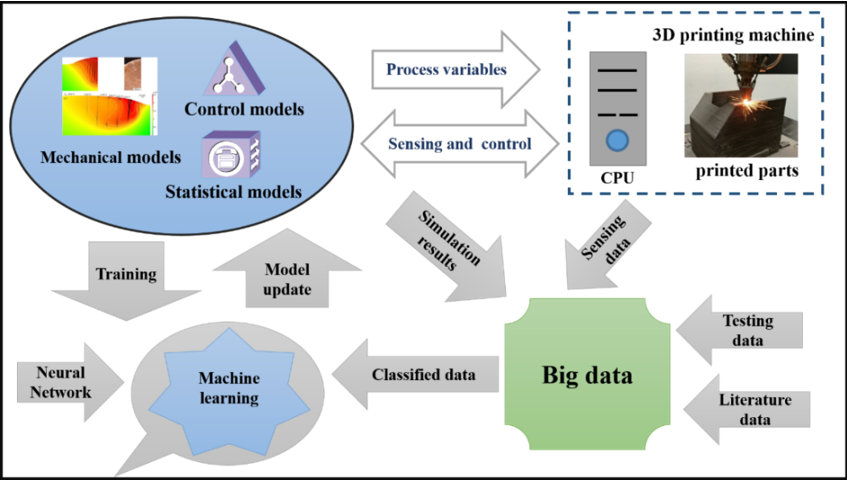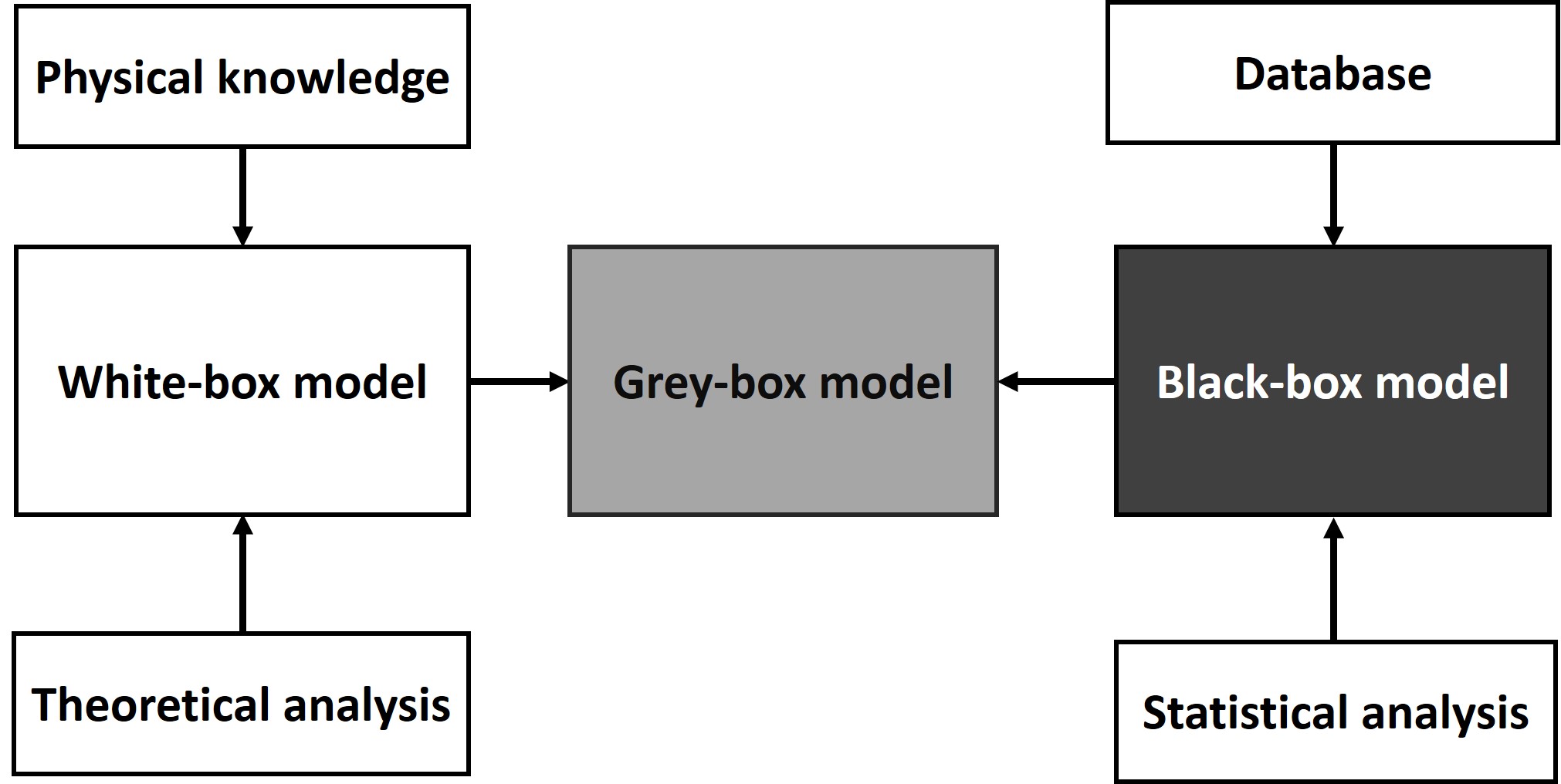
Video Upload Options
A brief state-of-the-art introduction of digital twins for additive manufacturing.
1. Introduction
Nowadays, an increasing number of customized products are needed, which is limited by the capability of the traditional manufacturing methods. Additive manufacturing (AM) is a relatively new way of providing them which is fundamentally different from formative or subtractive manufacturing. The designed structure can be built layer-by-layer directly, instead of casting, forging, or machining [1]. Through this method, nearly all kinds of non-standard structure and irregular workpieces can be made directly without wasting many materials. Thus, additive manufacturing is becoming one of the vital elements of the industrial revolution [2]. However, to produce components with sound structure and good mechanical properties, an optimized combination of appropriate parameters is important. To obtain optimal parameter combination only by trial and error is rather expensive, wastes material, and is time consuming, because numerous experiments are needed to optimize the process variables within given machines and parameter combination [3][4][5][6]. In-depth research is underway on the technologies of digitization, simulation [7][8][9], big data, and machine learning [10][11][12]. And there is a new approach, namely digital twins (DT), to overcome many additive manufacturing issues, such as improving part quality and shortening the time to qualify products. Digital twins are defined as a digital representation of a production system or service or just an active unique product characterized by certain properties or conditions. Through this method, the real physical world could be described by a cyber world. Thus, the physical properties of the components or equipment could be reflected in real-time by the digital model, which is visual and more easily observed. The digital twin system could be helpful to understand, analyze and improve the product, service system or production [13][14][15].
Thus, the digital twin approach can impact the additive manufacturing process by optimizing the process parameters, detecting, and monitoring the process faults, reducing the computational burden for multi-scale modeling, and dealing with the large volume of in situ sensor data [16].
Digital twins are being explored and gradually used in fields such as maintenance, repair, and overhauls etc., for example, decisionLab Ltd. and Siemens have developed a digital twin, ATOM, which can visualize fleet and maintenance facility operations, capture and predict key performance indicators (KPIs) of the system, and even quickly run a virtual and detailed scenery to help make decision of investment, driven by live data already available within the supply chain. However, the utilization of this technology in AM is still being developed. A lot of work is needed in order to push the digital twin technology forward to serve AM technology.
2. State of the Art of Digital Twin for Additive Manufacturing
The concept of digital twins was firstly proposed by National Aeronautics and Space Administration (NASA) to monitor the behaviors of a satellite. Using this method, the possible changes in the settings could also be simulated. NASA wanted to explore the space using a digital twin replica of the physical system [17]. After that, various studies were undertaken to develop this technology. Till now, it has been constructed and utilized for different manufacturing processes by many industries and government agencies [15].
Recent studies and research indicate that construction of a first-generation digital twin of AM is achievable. However, this technology is still in its infancy, and facing various research challenges. The components required to construct a digital twin of AM hardware, software, and related technologies are still under development and much work is still needed to fulfil its full functions [3].
DebRoy, Yang and their co-workers did lots of the pioneering work in this area [3][15][18]. They provided an overarching framework for the implementation, undertook lots of explorations to demonstrate this concept within the AM research community, and provided a perspective of the current status and research needed for the main building blocks of a first-generation digital twin of AM. In their research, they refer to the approach as the digital twin for AM and suggested that a digital twin of 3D printing [3][18] consists of a mechanistic model, a sensing and control model, a statistical model, as well as big data and machine learning, as shown in Figure 1.
Figure 1. Logical representation of the digital twin for additive manufacturing (AM) [9][15].
Knapp et al. [18] presented a novel framework of a mechanistic model to predict the melt-pool level phenomena. The 3D curved surface deposit geometry for single-pass deposits, transient temperature and velocity distributions, cooling rates, solidification parameters, and secondary dendrite arm spacing and micro-hardness were accurately estimated by the proposed building blocks in a computationally efficient manner. The author called it blocks of a first-generation digital twin of AM.
Yang [19] provided gray-box modeling for a powder bed fusion AM process and demonstrated that it can lower predictive errors, as shown in Figure 2, the basic idea of Yang’s team is to make predictions through calculation based on the data obtained, and gray-box modeling is the term used by them, not digital twin.
Figure 2. Gray-box model [19].
Gaikwad et al. [16] demonstrated an early foray of the digital twin paradigm for real-time process monitoring and defect prediction. In this research, the combination of physics-driven predictions with in-situ sensor data and machine learning led to higher statistical fidelity in detecting process flaws. The experiments of laser powder bed fusion (LPBF) and directed energy deposition (DED) metal AM processes were both conducted. The results substantiated this conclusion.
Chhetri et al. [20] did the first work that demonstrated how dynamic data-driven application systems enabled a feature re-ranking method that can help in keeping the digital twin up-to-date, as shown in Figure 3. The key performance indicator is the surface texture of the product and dimension of the object, which is simple and easy to observe. This could be taken as a prediction of the components’ “shape”, and the target is in a plastic form, which is quite different from the additive manufacturing of metal components.
Figure 3. Dynamic data-driven application systems enabled digital twin of additive manufacturing cyber-physical system [20].
All in all, the digital twin in additive manufacturing is a new concept, and the recent research has mainly focused on verifying the concept to predict the temperature distribution and thus to compute the defects that may occur and the relative properties such as the hardness and thermal strain [18]. Basically, the methods are mainly based on the finite element method, finite difference, level set method, volume of fluid method with finite difference method, lattice Boltzmann method and arbitrary Lagrangian–Eulerian, etc. [3]. They are more likely to be called “simulation” instead of “digital twin”.
References
- Tofail, S.A.M.; Koumoulos, E.P.; Bandyopadhyay, A.; Bose, S.; O’Donoghue, L.; Charitidis, C. Additive manufacturing: Scientific and technological challenges, market uptake and opportunities. Today 2018, 21, 22–37; doi:10.1016/j.mattod.2017.07.001.
- Dilberoglu, U.M.; Gharehpapagh, B.; Yaman, U.; Dolen, M. The Role of Additive Manufacturing in the Era of Industry 4.0. Manuf. 2017, 11, 545–554; doi:10.1016/j.promfg.2017.07.148.
- DebRoy, T.; Zhang, W.; Turner, J.; Babu, S.S. Building digital twins of 3D printing machines. Mater. 2017, 135, 119–124; doi:10.1016/j.scriptamat.2016.12.005.
- Manvatkar, V.; De, A.; DebRoy, T. Heat transfer and material flow during laser assisted multi-layer additive manufacturing. Appl. Phys. 2014, 116, 124905, doi:10.1063/1.4896751.
- Manvatkar, V.; De, A.; DebRoy, T. Spatial variation of melt pool geometry, peak temperature and solidification parameters during laser assisted additive manufacturing process. Sci. Technol. 2015, 31, 924–930; doi:10.1179/1743284714Y.0000000701.
- Raghavan, A.; Wei, H.L.; Palmer, T.A.; DebRoy, T. Heat transfer and fluid flow in additive manufacturing. Laser Appl. 2013, 25, 52006; doi:10.2351/1.4817788.
- Song, J.; Chew, Y.; Jiao, L.; Yao, X.; Moon, S.K.; Bi, G. Numerical study of temperature and cooling rate in selective laser melting with functionally graded support structures. Manuf. 2018, 24, 543–551; doi:10.1016/j.addma.2018.10.039.
- Loh, L.-E.; Song, J.; Guo, F.; Bi, G. Analytical Solution of Temperature Distribution in a Nonuniform Medium Due to a Moving Laser Beam and a Double Beam Scanning Strategy in the Selective Laser Melting Process. Heat Transf. 2018, 140; doi:10.1115/1.4040256.
- Song, J.; Chew, Y.; Bi, G.; Yao, X.; Zhang, B.; Bai, J.; Moon, S.K. Numerical and experimental study of laser aided additive manufacturing for melt-pool profile and grain orientation analysis. Design 2018, 137, 286–297; doi:10.1016/j.matdes.2017.10.033.
- Ren, K.; Chew, Y.; Zhang, Y.F.; Fuh, J.Y.H.; Bi, G.J. Thermal field prediction for laser scanning paths in laser aided additive manufacturing by physics-based machine learning. Methods Appl. Mech. Eng. 2020, 362, 112734; doi:10.1016/j.cma.2019.112734.
- Ren, K.; Chew, Y.; Zhang, Y.F.; Bi, G.J.; Fuh, J.Y.H. Thermal analyses for optimal scanning pattern evaluation in laser aided additive manufacturing. Mater. Proc. Technol. 2019, 271, 178–188; doi:10.1016/j.jmatprotec.2019.03.029.
- Ren, K.; Chew, Y.; Fuh, J.Y.H.; Zhang, Y.F.; Bi, G.J. Thermo-mechanical analyses for optimized path planning in laser aided additive manufacturing processes. Design 2019, 162, 80–93; doi:10.1016/j.matdes.2018.11.014.
- Stark, R.; Fresemann, C.; Lindow, K. Development and operation of Digital Twins for technical systems and services. CIRP Ann. 2019, 68, 129–132; doi:10.1016/j.cirp.2019.04.024.
- Schleich, B.; Anwer, N.; Mathieu, L.; Wartzack, S. Shaping the digital twin for design and production engineering. CIRP Ann. 2017, 66, 141–144; doi:10.1016/j.cirp.2017.04.040.
- Mukherjee, T.; DebRoy, T. A digital twin for rapid qualification of 3D printed metallic components. Mater. Today 2019, 14, 59–65; doi:10.1016/j.apmt.2018.11.003.
- Gaikwad, A.; Yavari, R.; Montazeri, M.; Cole, K.; Bian, L.; Rao, P. Toward the digital twin of additive manufacturing: Integrating thermal simulations, sensing, and analytics to detect process faults. IISE Trans. 2020, 52, 1204–1217; doi:10.1080/24725854.2019.1701753.
- Tuegel, E.J.; Ingraffea, A.R.; Eason, T.G.; Spottswood, S.M. Reengineering Aircraft Structural Life Prediction Using a Digital Twin. J. Aerosp. Eng. 2011, 2011, 1–14; doi:10.1155/2011/154798.
- Knapp, G.L.; Mukherjee, T.; Zuback, J.S.; Wei, H.L.; Palmer, T.A.; De, A.; DebRoy, T. Building blocks for a digital twin of additive manufacturing. Acta Mater. 2017, 135, 390–399; doi:10.1016/j.actamat.2017.06.039.
- Yang, Z. Model-Based Predictive Analytics for Additive and Smart Manufacturing. Ph.D. Dissertation; University of Massachusetts, Amherst, MA, USA, 2018.
- Chhetri, S.R.; Faezi, S.; al Faruque, M.A. Digital Twin of Manufacturing Systems: Technical Report on Digital Twin Project; Center for Embedded and Cyber-physical Systems (CECS): University of California, Irvine, USA, November 2017.







